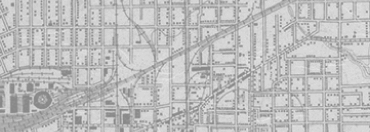


Back
Photograph of courtroom sketch of Henry Wade in final argument of Ruby trial
Photograph of courtroom pencil sketch on paper by CBS News courtroom artist Howard Brodie. The sketch shows District Attorney Henry Wade during the Jack Ruby trial on March 14, 1964. The sketch shows Wade standing with his hands on his hips looking towards the viewer's right. A handwritten caption in the upper right corner of the image reads "DA Wade in final argument 3/14/1964."Brodie made the original pencil sketches for CBS News during the trial of Jack Ruby after the judge barred cameras from the courtroom. Brodie then gave Joe Tonahill this photograph of a courtroom sketch as part of a collection of more than 40 in 1964.
Photograph of courtroom sketch of Henry Wade in final argument of Ruby trial
03/14/1964
Paper
14 5/8 × 19 3/8 in. (37.1 × 49.2 cm)
Tonahill Family Partners Collection/The Sixth Floor Museum at Dealey Plaza
2014.034.0009
Howard Brodie (1915-2010) was a sports artist for the San Francisco Chronicle when he enlisted in the U.S. Army with America's entry into World War II. He ultimately became one of the best-known sketch artists of the war, frequently published in the weekly U.S. military magazine, Yank, which ran from June 1942 to December 1945. After the war, Brodie spent the next thirty-five years as a courtroom artist, attending several notable trials including the Chicago Seven, Charles Manson and, of course, the Jack Ruby trial in 1964. For the Ruby trial, Brodie worked as a CBS-TV artist correspondent. Mr. Brodie recorded an oral history with the Museum in 2006. -- Stephen Fagin, Curator
Henry Wade (1914-2001) served as Dallas County District Attorney from 1951 to 1987. During the weekend of the Kennedy assassination, Wade became a familiar face on national television, frequently interviewed by the news media in the hallways of Dallas police headquarters. He gained further media attention for prosecuting Jack Ruby for Lee Harvey Oswald's murder in 1964. Though Wade supervised the prosecution closely, Assistant D.A. Bill Alexander handled most of the courtroom proceedings. In 1970, Wade was named defendant in a constitutional challenge to Texas abortion laws that ultimately went to the Supreme Court. Ten years after the Kennedy assassination, Henry Wade's name was once again etched into history with the Supreme Court's landmark Roe v. Wade decision in 1973 which made abortion legal in the United States. Wade recorded an oral history with The Sixth Floor Museum in 1992. His son, William Kim Wade, who witnessed the Kennedy motorcade as a ten-year-old, also recorded an oral history in 2013. -- Stephen Fagin, Curator
Photograph of courtroom sketch of Henry Wade in final argument of Ruby trial
Photograph of courtroom pencil sketch on paper by CBS News courtroom artist Howard Brodie. The sketch shows District Attorney Henry Wade during the Jack Ruby trial on March 14, 1964. The sketch shows Wade standing with his hands on his hips looking towards the viewer's right. A handwritten caption in the upper right corner of the image reads "DA Wade in final argument 3/14/1964."Brodie made the original pencil sketches for CBS News during the trial of Jack Ruby after the judge barred cameras from the courtroom. Brodie then gave Joe Tonahill this photograph of a courtroom sketch as part of a collection of more than 40 in 1964.
Photograph of courtroom sketch of Henry Wade in final argument of Ruby trial
03/14/1964
Photographs
Jack Ruby trial
Sketches
Attorney
Trials
Artist
Artwork
Brodie, Howard
Wade, Henry M.
CBS News
Dallas
Paper
14 5/8 × 19 3/8 in. (37.1 × 49.2 cm)
Tonahill Family Partners Collection/The Sixth Floor Museum at Dealey Plaza
2014.034.0009
Howard Brodie (1915-2010) was a sports artist for the San Francisco Chronicle when he enlisted in the U.S. Army with America's entry into World War II. He ultimately became one of the best-known sketch artists of the war, frequently published in the weekly U.S. military magazine, Yank, which ran from June 1942 to December 1945. After the war, Brodie spent the next thirty-five years as a courtroom artist, attending several notable trials including the Chicago Seven, Charles Manson and, of course, the Jack Ruby trial in 1964. For the Ruby trial, Brodie worked as a CBS-TV artist correspondent. Mr. Brodie recorded an oral history with the Museum in 2006. -- Stephen Fagin, Curator
Henry Wade (1914-2001) served as Dallas County District Attorney from 1951 to 1987. During the weekend of the Kennedy assassination, Wade became a familiar face on national television, frequently interviewed by the news media in the hallways of Dallas police headquarters. He gained further media attention for prosecuting Jack Ruby for Lee Harvey Oswald's murder in 1964. Though Wade supervised the prosecution closely, Assistant D.A. Bill Alexander handled most of the courtroom proceedings. In 1970, Wade was named defendant in a constitutional challenge to Texas abortion laws that ultimately went to the Supreme Court. Ten years after the Kennedy assassination, Henry Wade's name was once again etched into history with the Supreme Court's landmark Roe v. Wade decision in 1973 which made abortion legal in the United States. Wade recorded an oral history with The Sixth Floor Museum in 1992. His son, William Kim Wade, who witnessed the Kennedy motorcade as a ten-year-old, also recorded an oral history in 2013. -- Stephen Fagin, Curator









